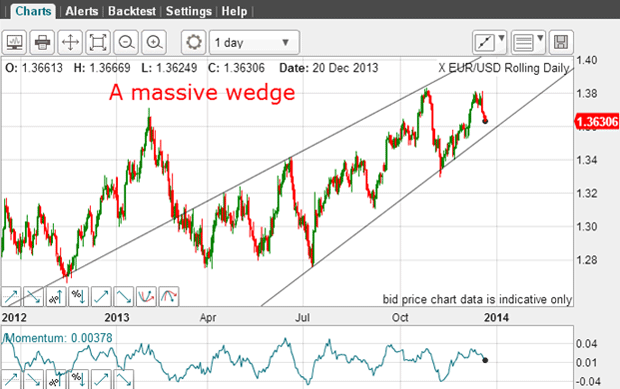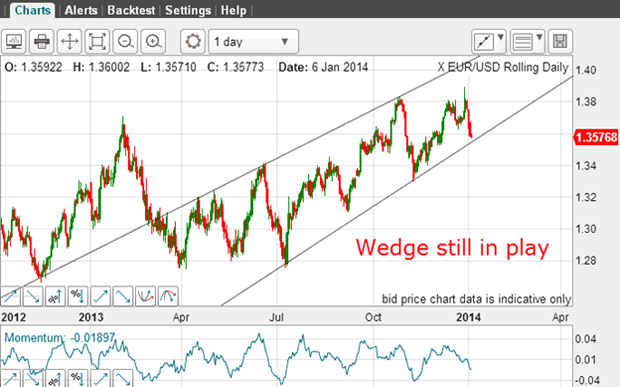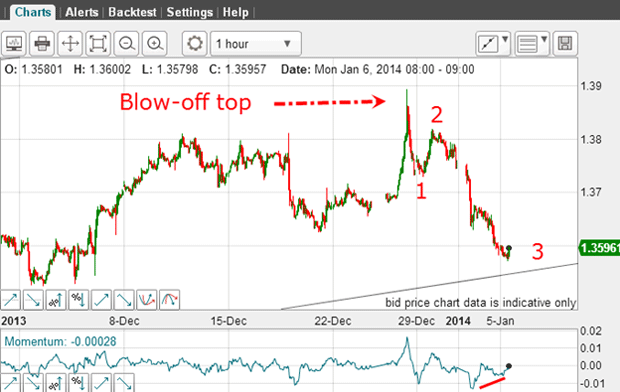Has the euro topped out in the market?
The euro made a top just before the Christmas break, and since then the single currency has fallen hard. John C Burford explains why.
Since the start of the New Year, many markets seem to have changed direction. This is especially true for the dollar. What could have happened to induce these totally unexpected changes?
As they say, nobody rings a bell at the top. So what is it that causes a major market such as the dollar to change direction?
During big rallies, such as we have seen in the EUR/USD, there was no shortage of reasons offered by pundits for the bull move. Last year, we were told that the eurozone sovereign debt crisis had passed. Bond yields of the debt of Spain, Greece and other problem' countries were falling and were reaching safe' levels.
MoneyWeek
Subscribe to MoneyWeek today and get your first six magazine issues absolutely FREE

Sign up to Money Morning
Don't miss the latest investment and personal finances news, market analysis, plus money-saving tips with our free twice-daily newsletter
Don't miss the latest investment and personal finances news, market analysis, plus money-saving tips with our free twice-daily newsletter
At the same time, spreads over the German bonds reached very low levels. The euro was seen as a solid bet again. Confidence had returned.
But just before the holiday break, the EUR/USD made a top and has fallen sharply since then. This was my chart from last time I covered the euro on 20 December:

But the market had not finished its rally and it made one more final push up. Here is the chart updated to this morning:

The rally pushed past the critical 1.38 level, but was met with heavy selling. This produced the key reversal in the Dollar Index, which I showed last time. The euro is the largest component in the Dollar Index, which is made up of a basket of currencies. They trade very much in anti-sync.
Why the euro fell
The fact is that markets are moved by changes in aggregate sentiment of the traders. This is an unseen effect that only manifests as a change in direction of the market. Major market turns are made when the majority least expect it.
But even with the sharp decline off last year's high, my lower wedge line on the daily chart has not been broken and the major trend remains up. But the market is getting very close to the line. And if it breaks, that should confirm the trend was now firmly down.
What information can the hourly chart divulge?

I have called the 1.39 high as a blow-off top. This is where the market made a desperate lunge into a new high as it took out the multitude of protective buy-stops placed above the 1.38 level. This level was widely watched by many traders.
The buying then became exhausted as some longs decided to take profits and new shorts emerged to reverse the market. This occurred outside of any fundamental' news development.
There was a major shorting opportunity when the market broke below the wave 1 low.
The basic rule of trading
And when this wave 4 completes, we should see a fifth wave down. That could perhaps take it below my lower wedge line. That will be my roadmap. If the market veers off this road, I shall be amending it accordingly.
Remember the basic approach to trading is this: let the market speak to you, and make sure you listen!
Get the latest financial news, insights and expert analysis from our award-winning MoneyWeek team, to help you understand what really matters when it comes to your finances.
John is is a British-born lapsed PhD physicist, who previously worked for Nasa on the Mars exploration team. He is a former commodity trading advisor with the US Commodities Futures Trading Commission, and worked in a boutique futures house in California in the 1980s.
He was a partner in one of the first futures newsletter advisory services, based in Washington DC, specialising in pork bellies and currencies. John is primarily a chart-reading trader, having cut his trading teeth in the days before PCs.
As well as his work in the financial world, he has launched, run and sold several 'real' businesses producing 'real' products.
-
 High earners face £15k income hit by 2029 following Autumn Budget
High earners face £15k income hit by 2029 following Autumn BudgetRachel Reeves’s Autumn Budget means high earners – or HENRYs – are now looking at an income hit running into the thousands. Can you avoid it?
-
 Millions underestimate how many paydays are left until retirement - why you should be counting your payslips
Millions underestimate how many paydays are left until retirement - why you should be counting your payslipsKeeping track of how long you will be earning a salary for can help work out how much you need to put into a workplace pension